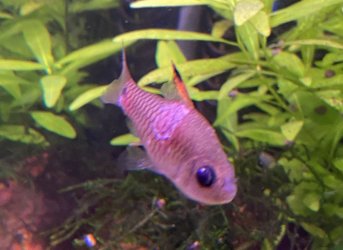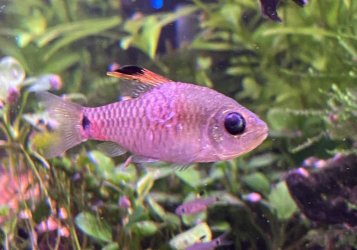dubadotcom
New Member
I have had a shoal of Drape Fin Barb (oreichthys crenuchoides) for over two years and they are fantastic. It's been wonderful watching them grow up. I started with three males and three females, but have lost two females recently and under strange circumstances.
They have always seemed happy and healthy. I've never seen any aggression, since reaching maturity they've been breeding unaided (advice on which this forum graciously provided) and I've never noticed any behavioural or health issues.
Yet about a month ago one of the females was found on the floor near the tank, and far too late. I was completely shocked, but I've never seen any chasing and thought it must have been an anomaly. Really, they all seem to get along famously.
Last night I came home and noticed another female missing. After searching for ages I found the poor thing, deceased and somehow completely wedged between a decoration and the glass of the tank. Buried in the substrate as if trying desperately to escape something. It was heartbreaking!
And today, my third female has an injury (image attached). She is acting normally if a bit jittery—not timid or shy or hiding. She's interacting with the others and even courting a bit.
The obvious answer is that the females are being terrorised when I'm not looking. I acknowledge this is very possible, but I cannot express enough that I have never seen any aggressive behaviour in this group.
What can I do to help her? And what can I do about the bigger issue here? Please help if you're able.
They live in a 70l community tank with four dwarf gouramis, a pleco, one ageing guppy (long story), some shrimp and a scattering of their fry I haven't been able to catch and re-home yet.
Thank you!
They have always seemed happy and healthy. I've never seen any aggression, since reaching maturity they've been breeding unaided (advice on which this forum graciously provided) and I've never noticed any behavioural or health issues.
Yet about a month ago one of the females was found on the floor near the tank, and far too late. I was completely shocked, but I've never seen any chasing and thought it must have been an anomaly. Really, they all seem to get along famously.
Last night I came home and noticed another female missing. After searching for ages I found the poor thing, deceased and somehow completely wedged between a decoration and the glass of the tank. Buried in the substrate as if trying desperately to escape something. It was heartbreaking!
And today, my third female has an injury (image attached). She is acting normally if a bit jittery—not timid or shy or hiding. She's interacting with the others and even courting a bit.
The obvious answer is that the females are being terrorised when I'm not looking. I acknowledge this is very possible, but I cannot express enough that I have never seen any aggressive behaviour in this group.
What can I do to help her? And what can I do about the bigger issue here? Please help if you're able.
They live in a 70l community tank with four dwarf gouramis, a pleco, one ageing guppy (long story), some shrimp and a scattering of their fry I haven't been able to catch and re-home yet.
Thank you!






